This post may contain affiliate links, meaning that if you click and make a purchase, I may earn a commission at no additional cost to you. Read the full disclosure here.
Last Updated: April 4, 2025
Driving by car is a great way to explore France, travel on your own schedule, and see areas of the country that are harder to access by public transportation. As an American, you’ll find that driving in France is not all that different from driving in the United States.
Whether you are planning to drive in France in a rental car as a tourist or you’ve just moved here, it’s essential to take note of the rules of the road. Let’s look at some of the key differences and important road signs so that you know what to expect when driving in France.
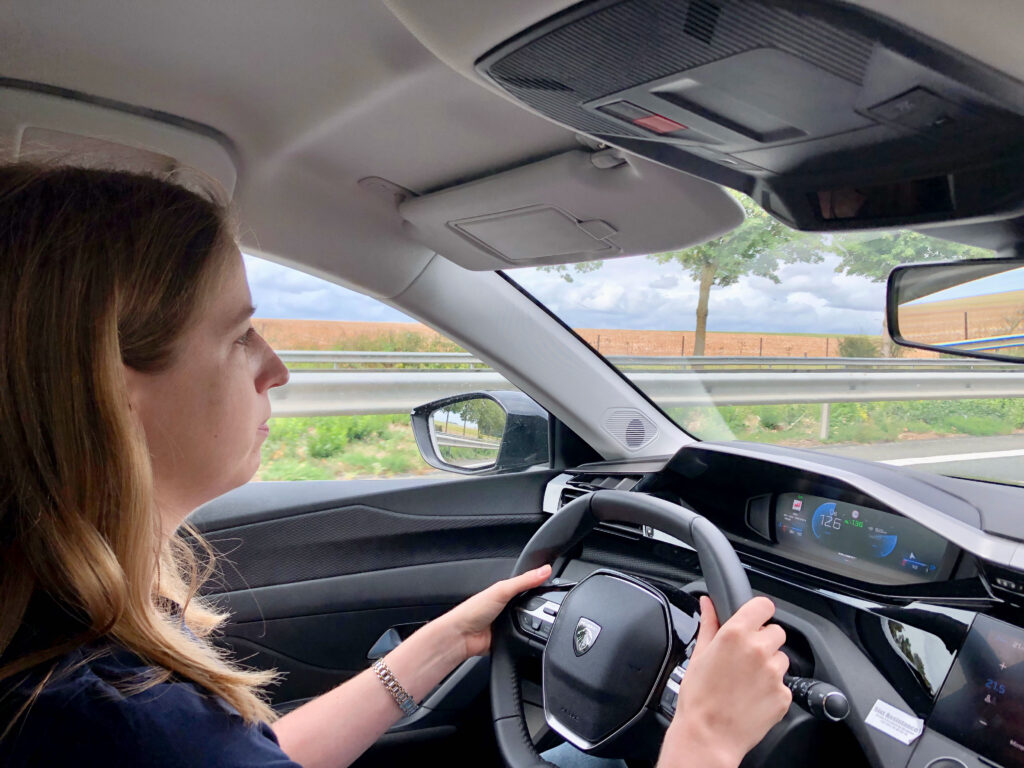
Can you drive in France on a US license?
As a short-stay visitor, you can drive in France on your US driver’s license. It’s a good idea to bring an International Driver’s Permit (IDP) with you. This is simply a translation of your driving license. It is not valid on its own and must accompany your actual driving license. You can obtain one quickly, easily, and cheaply from your local American Automotive Association (AAA).
If you’re in France for a longer stay, keep in mind that your American driver’s license is only valid on French territory for one year. You’ll need to consider exchanging your US driving permit for a French permit or going through the process of preparing for the French driving tests and applying for a license in your own right.
Can you rent a car in France with an American license?
You can rent a car in France with a US driver’s license. If a license is not written in French, it should be accompanied by an official French translation or an IDP (see above). In practice, an IDP is not necessarily required. The rental agency can ask you to present an IDP but they might not request it at all.
Each rental agency has their own terms and conditions for renting. Most car rental agencies in France impose a minimum age of 18 years (or more for certain vehicles) and at least one year (sometimes two years) of experience. Additionally, there are supplementary charges for younger drivers. Anyone below the age of 25 is generally considered a young driver.
While manual cars are very common throughout Europe, there are also options for automatic cars. The rental price for automatic cars is typically higher.
It’s beneficial to shop around when choosing a car rental agency. Compare costs as well as terms and conditions.
How is driving in France different from driving in the States?
Driving in France is not too different from driving in the United States and should be fairly manageable for an American to handle. Here are a few noteworthy differences to keep in mind before getting behind the wheel. This is based on what stood out to me!
Traffic Circles
While the United States is ruled by stop signs and traffic lights, France is primarily ruled by traffic circles. Known as un rond-point in French, roundabouts are super practical, allowing for a continuous flow of traffic.
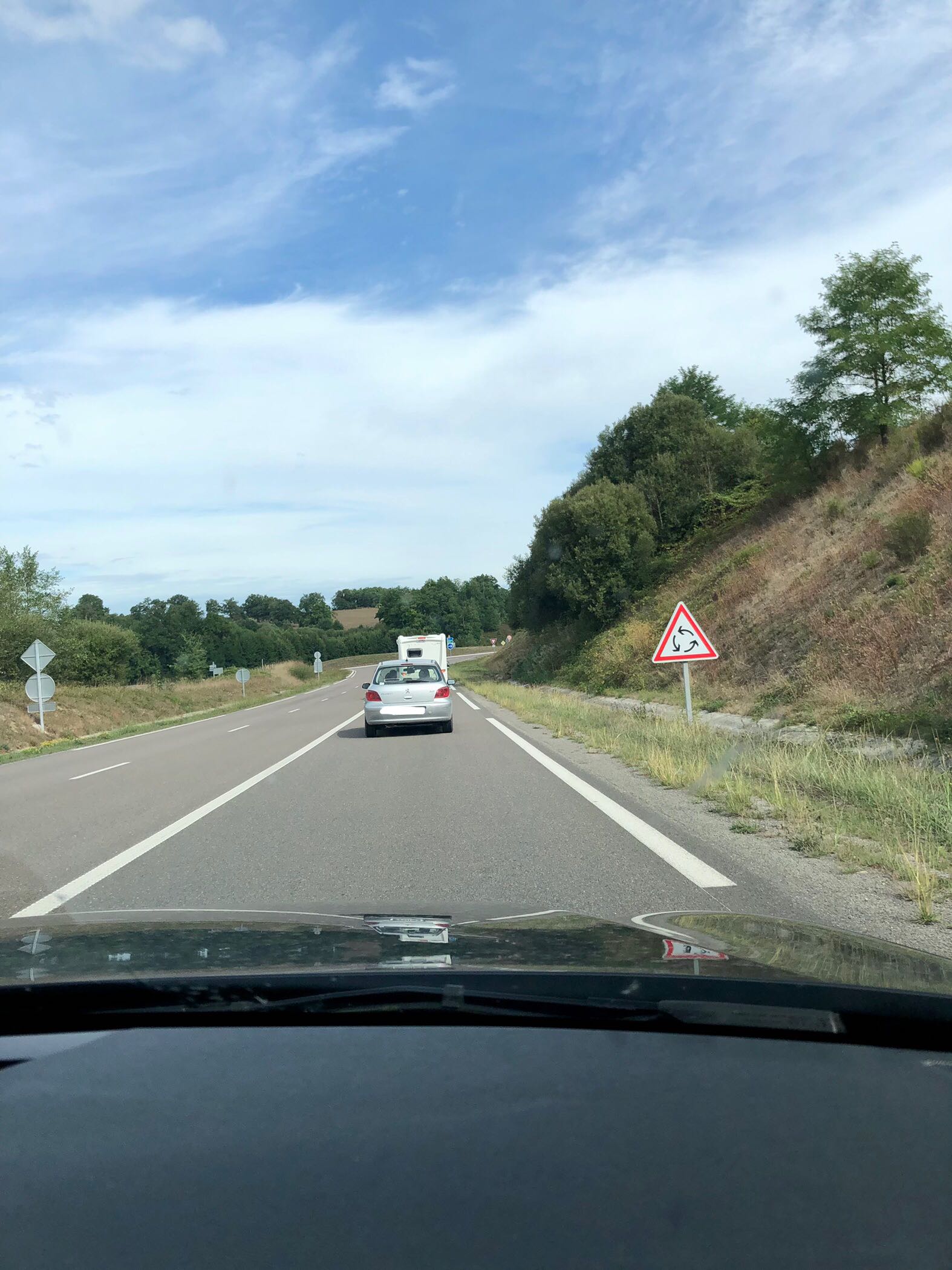
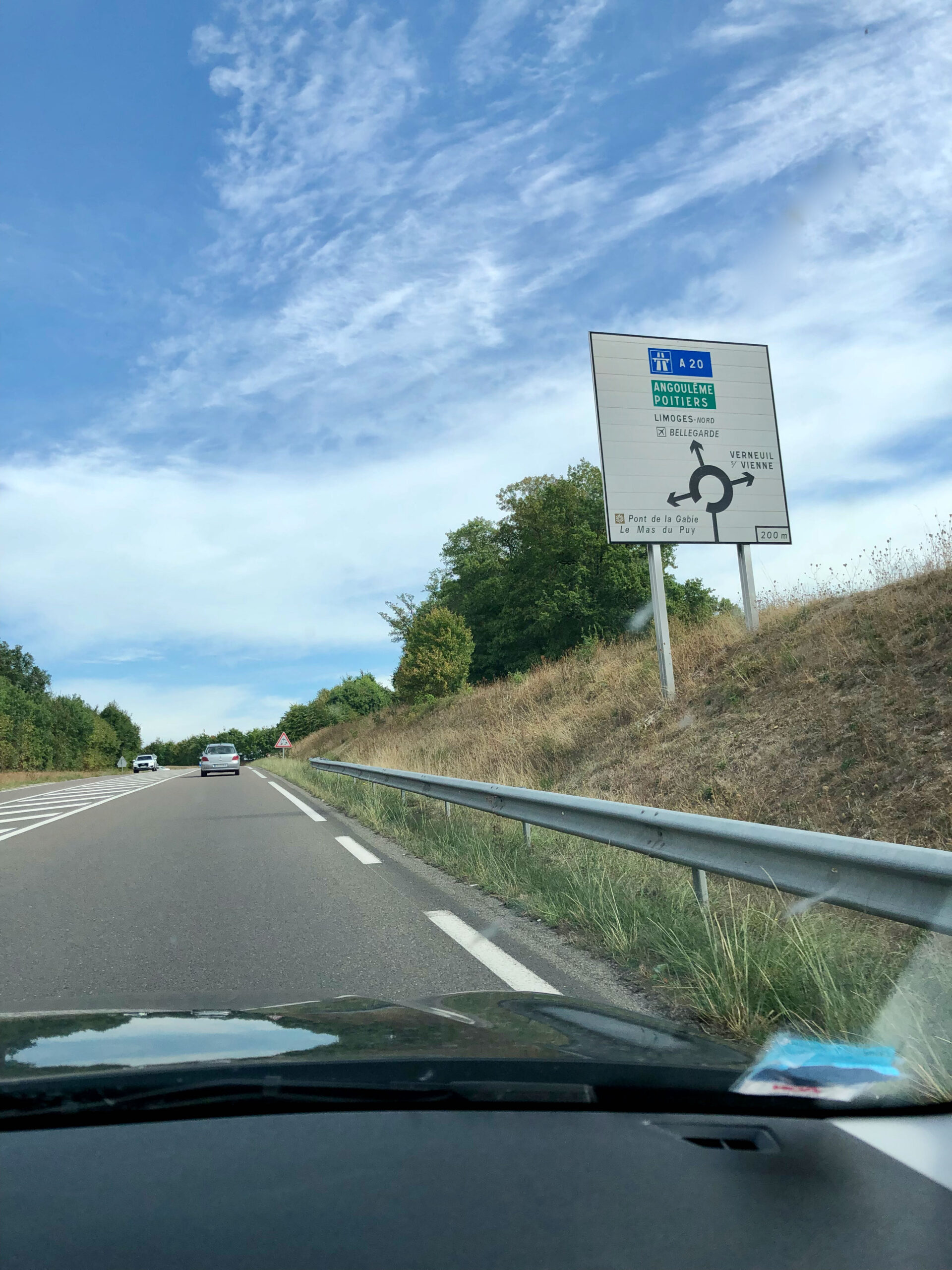
In truth, you can go around as many times as you like in order to verify signage and make sure you head off in the right direction. If you’re traveling around more than half of the roundabout, keep to the left lane (if there is one). Keep your left turn signal on until you are ready to exit. A right turn signal will allow others to know that you are exiting. Be sure to check your blind spot on the right before leaving the rotary.
If you’re having a hard time visualizing what’s going on here, you’d definitely benefit from the 360º driving tours offered in the Tripiamo France Driving Guide. Sitting in the car during the tour will help you virtually experience and practice what it’s actually like going through a traffic circle in France.
Related: Gain the Confidence to Drive Anywhere With Tripiamo
Priorité à droite
Priorité à droite is a fundamental French driving rule that can cause confusion for foreigners and natives alike. The basic tenet of priorité à droite is that you must yield to cars entering from the right. In this way, even if you are driving along a main road, you might find a car suddenly pulling out in front of you from a minor road. This can be confusing (and dangerous!) for Americans who are used to having priority on a main road.
Related: 15+ Signs You’re an American Expat Living in France
Although priorité à droite is the default rule for determining who has the right of way, there are so many signs around France indicating when it is not in effect that one wonders why they didn’t just repeal this rule in its entirety.
At a rond-point, if we’re abiding to priorité à droite, those in the traffic circle are supposed to yield to those entering. Indeed, this is the case for perhaps the most frightening of all the French roundabouts… I’m speaking, of course, of the rotary around the Arc de Triomphe. However, most traffic circles throughout France these days have a cédez le passage sign for those entering to yield to those already in the roundabout. This will probably feel like common sense to you!
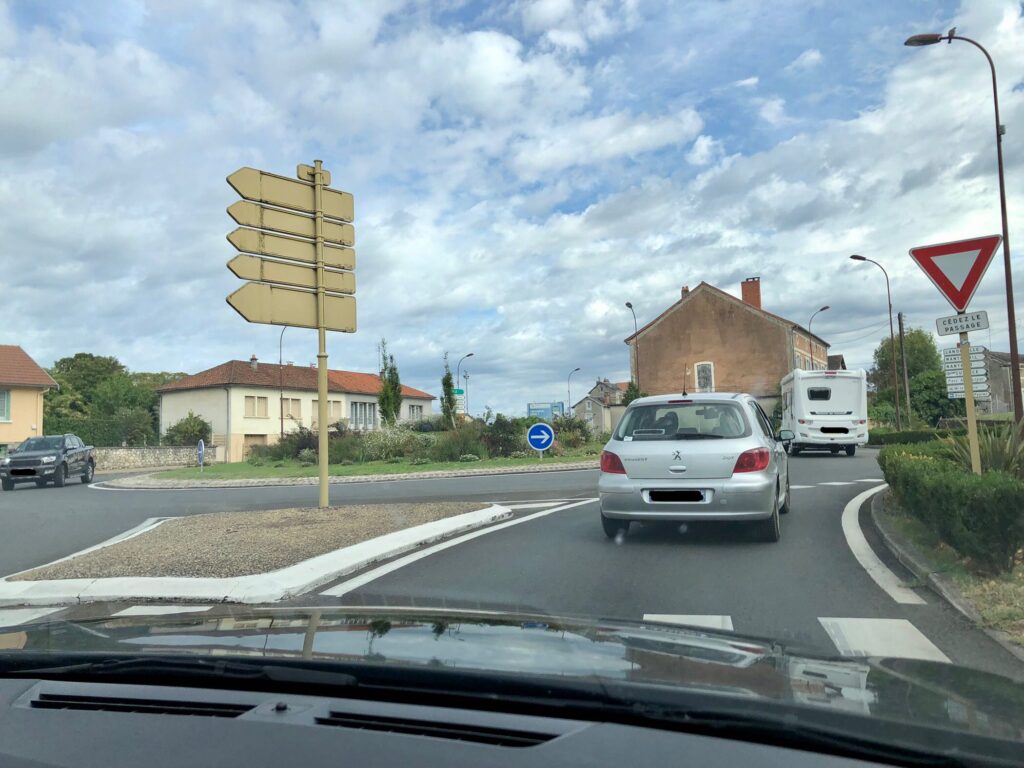
A yellow square (diamond) sign means that you have the right of way and priorité à droite does not apply. Many major routes will have signs like this. When you see that the yellow square has been crossed out, priorité à droite is back in force. This is frequently the case when entering a town or village.
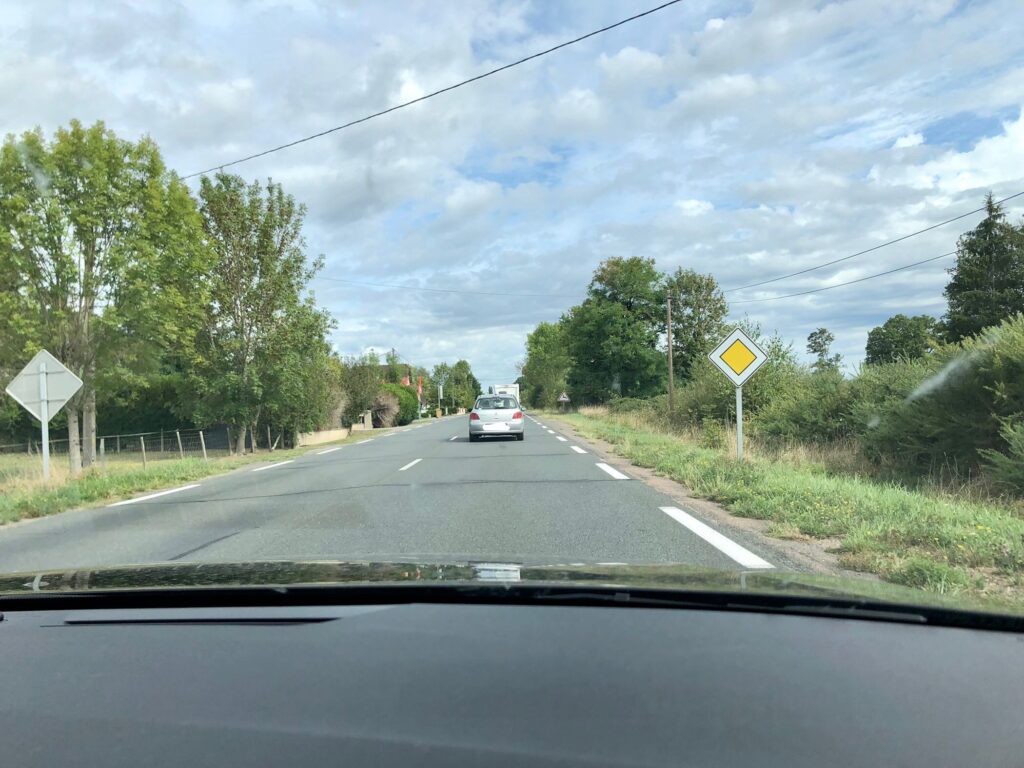
Another indication that drivers on the main street have priority over minor streets is if you see a solid white line on the minor road. This signifies that the driver on the smaller road needs to stop, thereby yielding to the cars already on the main street.
Right on Red? Don’t even think about it!
As you roll to a stop at a traffic light, resist the urge to creep forward in preparation for making a right turn on red. Unlike in the States, this is not the default. Right on red is not allowed in France unless otherwise indicated.
Read more: Things You Can Do in the United States That You Can’t Do in France
Speed Limits
Take note that speed limits are indicated in kilometers per hour (kph), not miles per hour (mph) 😉
What I find most frustrating about driving in France is that the speed limit is not always displayed. Sometimes, you’ll simply encounter a sign indicating that a certain speed limit is no longer being imposed and you can return to the normal speed limit. It’s expected that you know what type of road you are driving on and the speed limits that are associated with that type of road.


This is not a big deal and certainly something you can get used to, but it can be a bit disconcerting when you’re unsure! I found that the GPS on my phone is often, but not always, accurate in displaying the speed limit. Keeping up with traffic can be a good rule of thumb as well.
It is rare to see police pulling cars over. Speed limits are most often enforced by radars. If you’re speeding, you’ll be sent the fine by mail. This is also the case if you are renting the car. Don’t worry—They’ll forward any fines along to you!
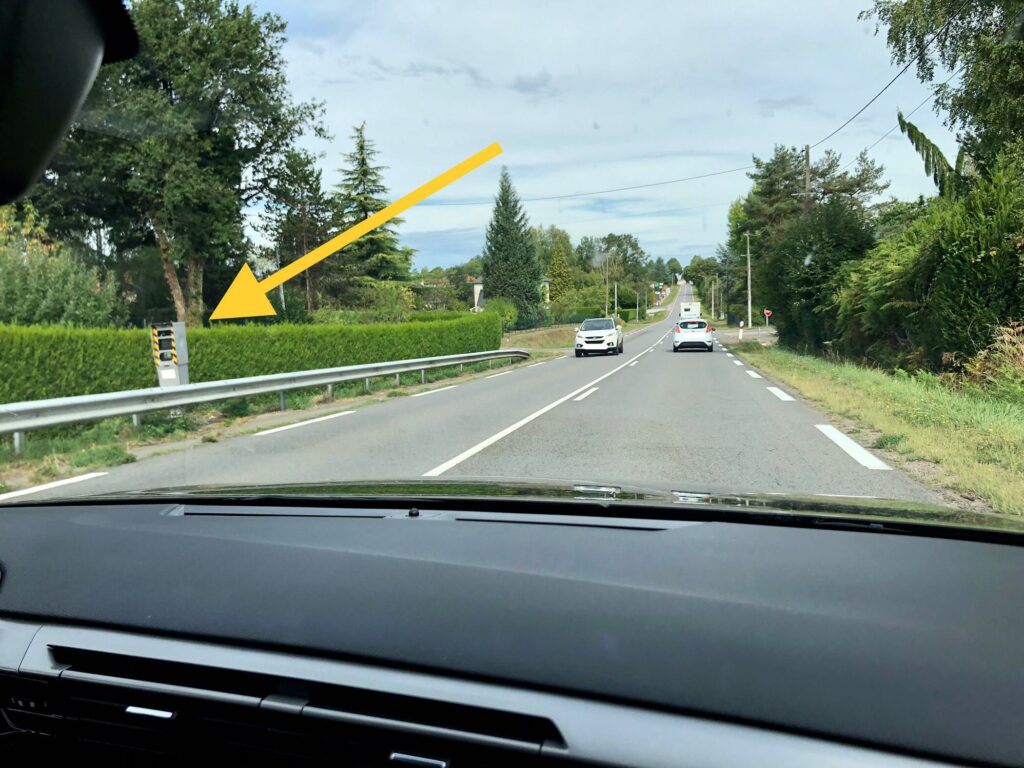
Types of Roads
Autoroutes in France are highways designated by the letter A followed by numbers. They are generally the most efficient route to take when driving for a long distance across the country. The speed limit is 130 kph but this decreases to 110 kph when it’s raining. There are often tolls (péages) to use these motorways which you can pay by credit card or cash.
When on an autoroute or other major motorway, you should drive on the right and pass on the left. If you are not actively passing someone, you should move over to the right lane. When there are more than two lanes, the slowest vehicles (like trucks) typically travel in the farthest right lane. In this case, you can travel in the middle lane.
Note: If you are driving in a middle lane and you see that the car behind you is flashing their lights, this could be signal that something is wrong with your car or you left a turn signal on, etc. However, what’s more likely is that they are giving you encouragement to drive a bit faster!! If you are going exactly the speed limit, consider yourself a slow moving vehicle and move over to the right lane.
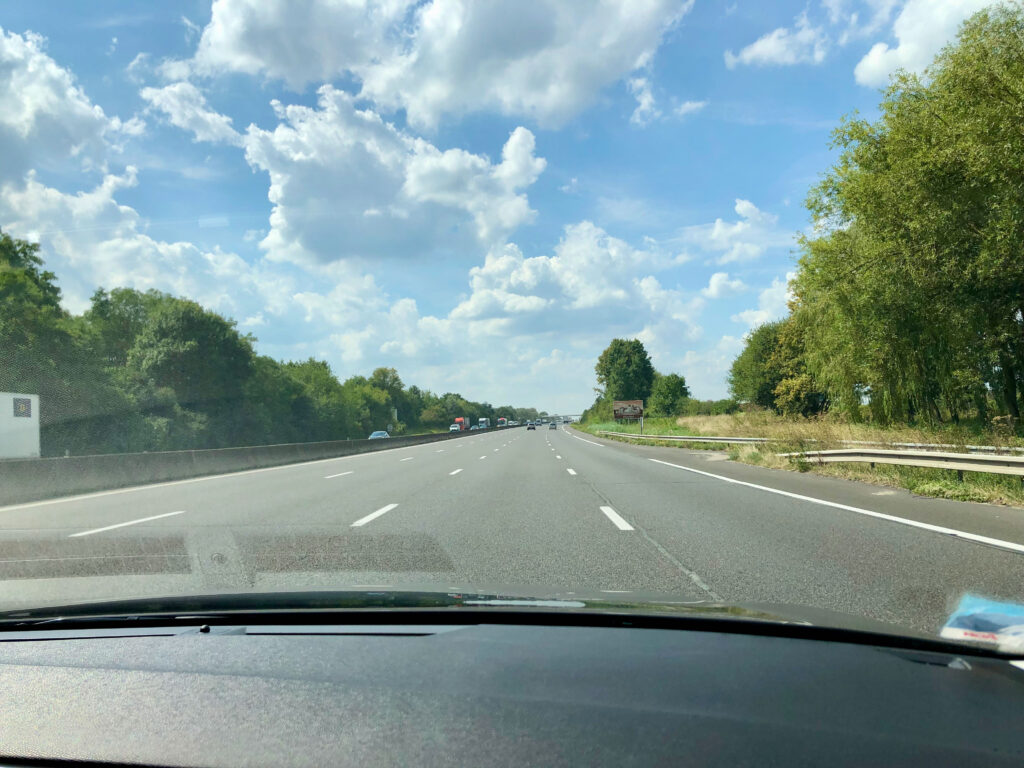
Routes Nationales in France are designated by the letter N followed by numbers. Routes Départementales are designated by the letter D followed by numbers. Both are generally toll-free, yet larger and with higher speed limits than communal roads.
When in a town or rural area, communal roads can be quite narrow in some areas. It’s often necessary to pull off the road slightly in order to provide enough room for a car coming in the opposite direction to pass by.
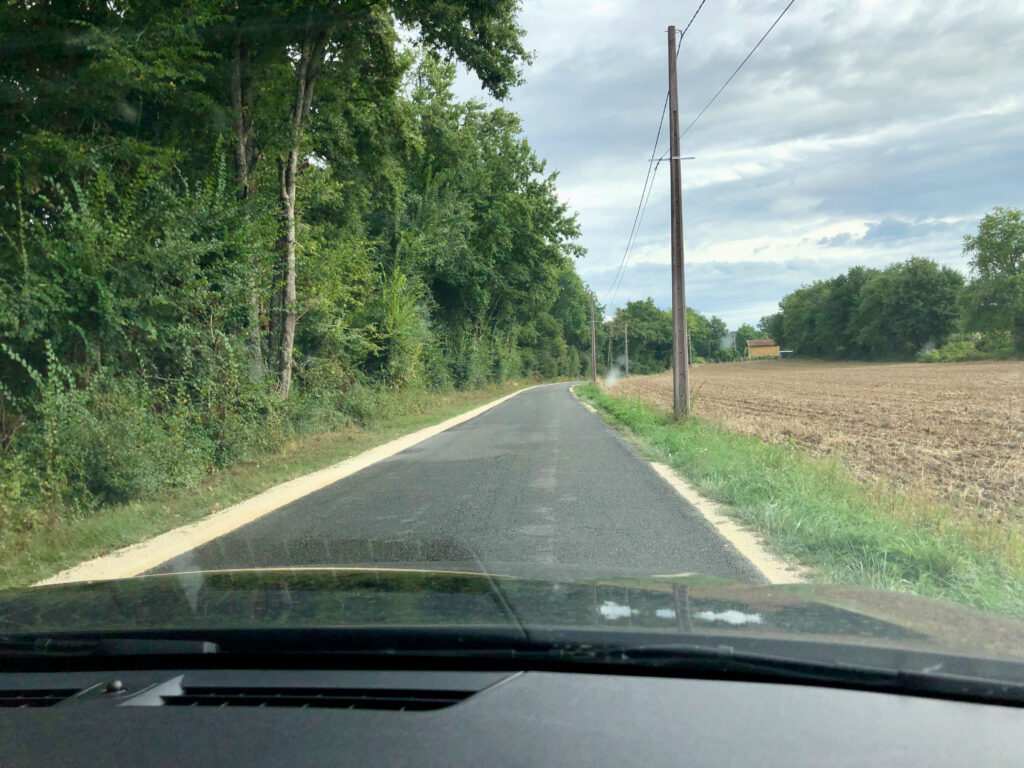
Bonus! Driving Tips for Paris!
Notoriously busy, driving in Paris is not for the faint of heart. It can be a bit stressful, so if you can avoid it, I would strongly advise against driving in Paris. Public transportation in Paris is great and will probably get you where you’re going faster than taking a car.
However, sometimes it’s unavoidable, like if you’re renting a car to head out of the city for a day trip. Here are some tips for driving in the capital:
- Plan your route in advance and avoid major ronds-points if you can. Trust me, you won’t enjoy the Arc de Triomphe nearly as much if you’re driving around it in a car.
- Most streets in Paris are limited to 30 kph.
- Be assertive! Just like in any large city, drivers can be a bit aggressive, so stand your ground (within reason!).
- Be wary of those on scooters! They don’t seem to follow any rules of the road.
- Keep an eye out for pedestrians and cyclists as well. While more reasonable than the rogue scooter, they can’t be fully trusted either.
- The first Sunday of the month, the Champs-Élysées and central Paris are reserved for pedestrians. See a map of all pedestrian zones in Paris here.
- When heading back to Paris, gas up outside of the city. Pumps in the city are hard to locate and very pricey.
- Tapping bumpers when street parking in Paris is standard practice. (But don’t tell anyone I told you that.)
- Parking garages are often tucked away underground. While a more expensive option, this will save you time from trying to find a spot on the street as well as the hassle of parallel parking under pressure!
- For more info on parking fees and suggestions for parking apps, check out the City of Paris website.
Did this guide help you? Say thanks with a cup of coffee!
Have you ever driven in France? What advice might you offer to an American driving in France for the first time?
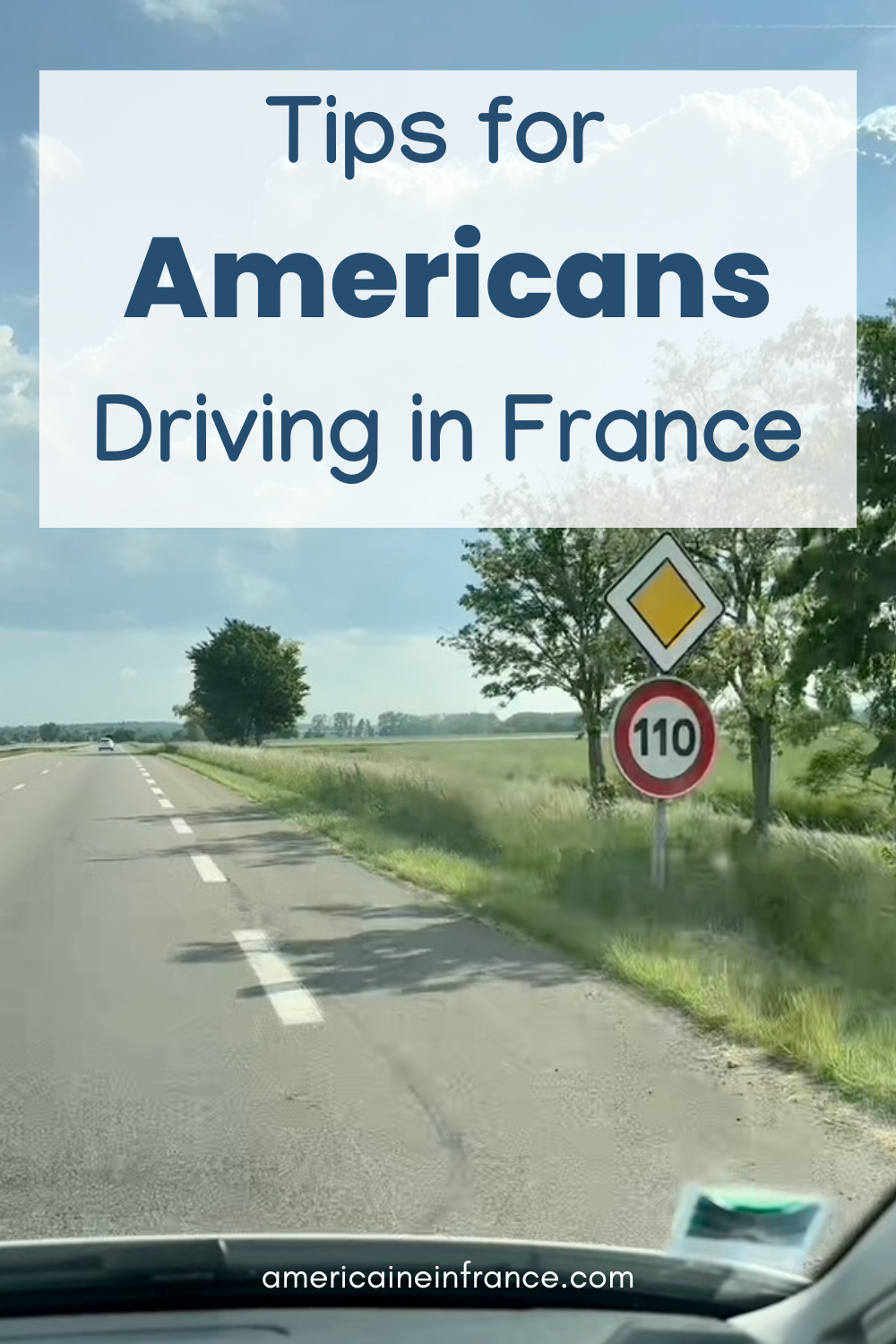
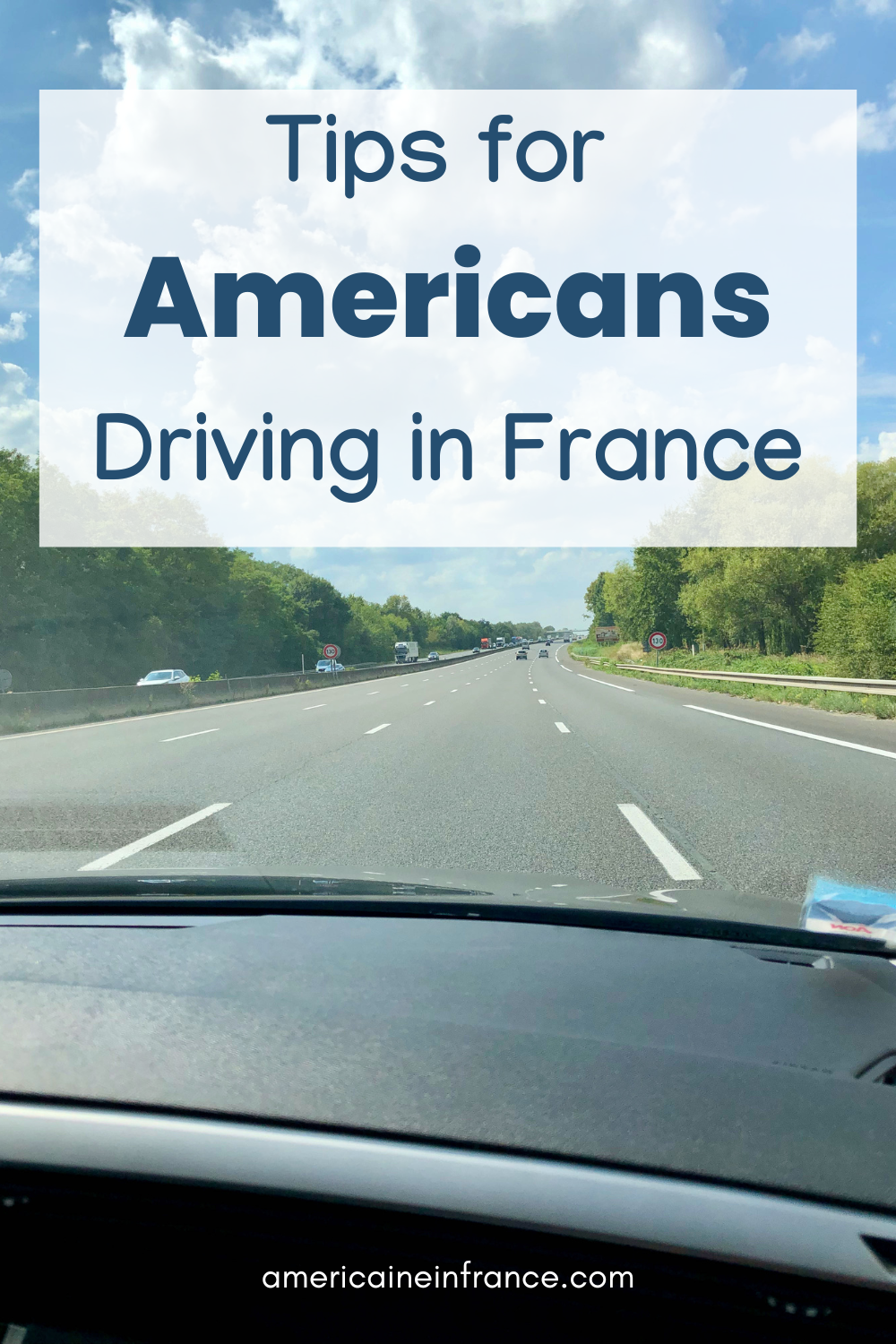
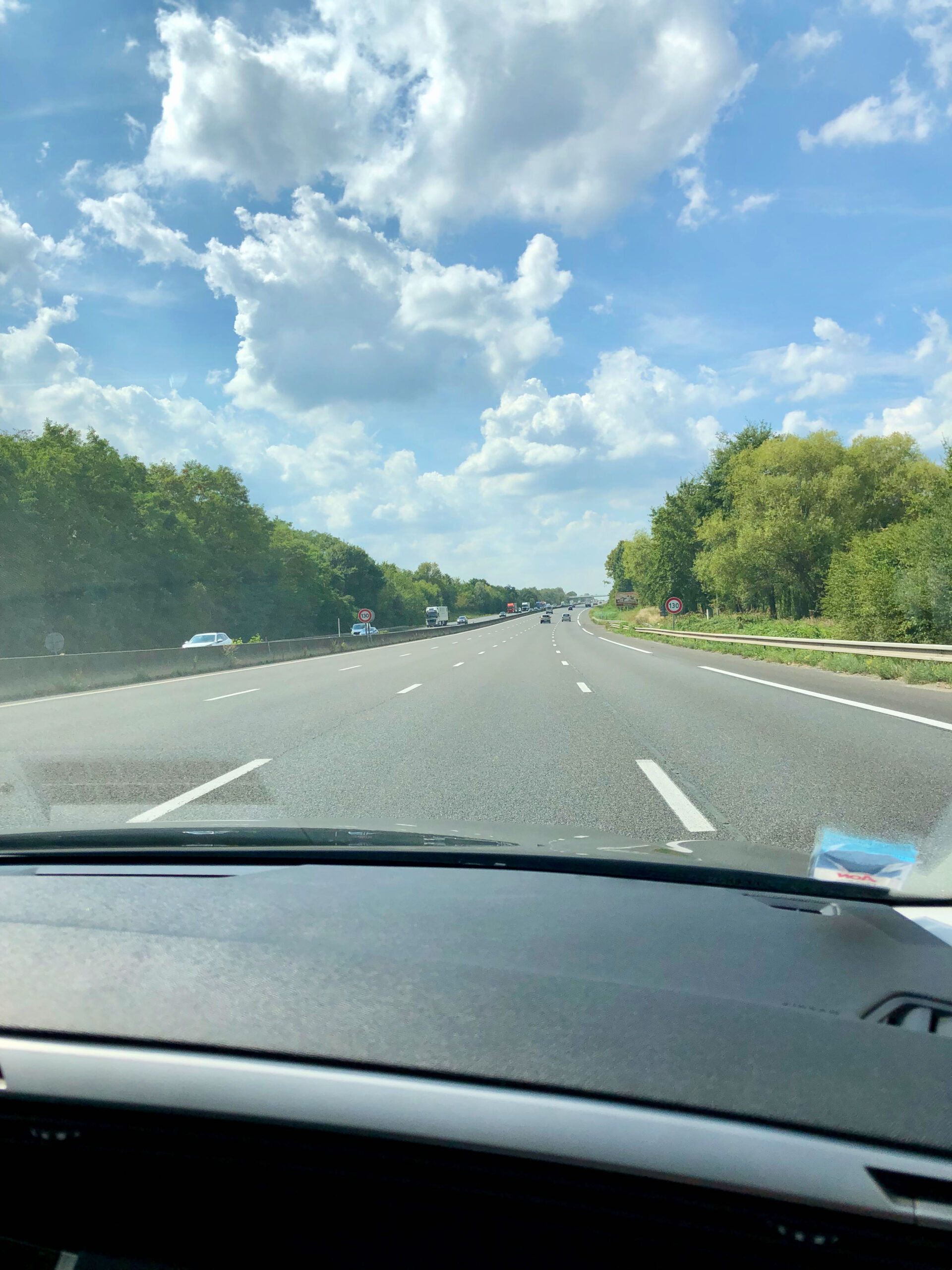
Amazing tips, thank you!
Happy to help 🙂
I was just there and am still confused why cars behind were flashing their lights at me every now and then. Did they want to pass or expecte.to pull.more to the right? Because this happened on a major route with 3 lanes with me I’m the middle
Hi Joshua,
Great question! If a car behind you is flashing their lights, they could be trying to signal to you that something is wrong with your car, like a tail light is out or you left a turn signal on, etc. What’s more likely though is that they are giving you encouragement to drive a bit faster! It’s been my experience that drivers in France tend to drive over the speed limit, especially if they’re familiar with the area and know that there aren’t any speed radars nearby.
Thanks for reaching out. Hope you had a nice time here 🙂
Ellen
This is a very informative blog post/article. I was a little concerned about driving in France, but your post put me much more at ease. We are driving a rental car from Charles de Gaulle Airport to an AirBNB in Bagnolet, then driving to and from the Normandy D-Day beaches the next day (a Sunday) and returning the car to the airport the following morning and using public transportation for the rest of our trip. Do the “driving in Paris” cautions apply to driving between CDG and Bagnolet? Any advice about driving to/from Normandy?
FWIW, I’ve driven in several large US cities (LA, San Francisco, Washington DC) with which I wasn’t especially familiar, and have also driven in the metro São Paulo, Brazil area a few years ago. Thanks!
I’m so happy to hear that this post has put you more at ease. Thanks for letting me know, Stephan!
Since you’ll be driving from CDG to Bagnolet, you will likely not be crossing into Paris proper which is designated by a ring road called Boulevard Périphérique. Outside of the ring road, you will be in greater Paris, in the suburbs. Many of the tips I mentioned still apply but overall, you’ll likely encounter much less congestion than if you were in central Paris. Sounds like you have plenty of experience driving in major cities, so I think you’ll manage well!
I don’t have any specific tips for driving to/from Normandy. It’s a great area to visit with a car so that you can see everything you want to. Enjoy your trip!
Ellen
Heading over in just a few days. Great information. Thanks for sharing your knowledge.
So glad this was helpful. Have a great trip, Tom!
What does “tapping bumpers” while parking in Paris mean?
Hi Roni,
Tapping bumpers most often happens when parallel parking. While maneuvering into the spot, you accidentally bump against another car. It’s true that you can regularly witness Parisians doing this as the spots on the street can be tight. However this “tip” was strictly meant as a joke 😉, so I don’t recommend doing it purposefully!
Happy driving in Paris!
Best,
Ellen